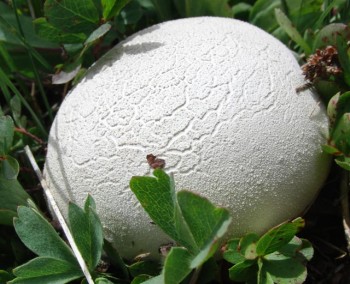
All this rain is making the mushrooms come out—a connection I never made before since I’m pretty much a beginner with edible fungi. So, when Gregg and I took a long, off trail hike above our house to an isolated beaver pond at 12,000 feet, crossing an above tree-line meadow to get there, I was beyond surprised to find three large puffball mushrooms the size of my fist growing there.
Puffballs can grow to enormous sizes, so these were not necessarily all that big. According to coloradomushrooms.com, the Western Giant Puffball (Calvatia booniana), which is found in open fields at high elevations, can grow as large as a soccer ball. “Wildman” Steve Brill has a nice picture of a giant puffball at his website if you want to get a sense of their potential. Imagine eating one of those babies!
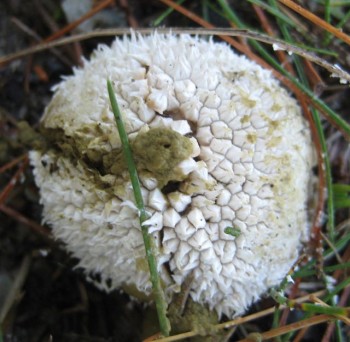
Puffballs Past
I may be a beginner with edible fungi, but I’m not completely uninitiated. As a child I ate a few small puffballs sliced and fried in butter at my uncle’s behest and much to my mother’s consternation. I was enthralled both by the taste and the fact that you could find such fare in nature. (After all, doesn’t most everything we eat come from the aisles of a grocery store?)
Later that week, after my uncle left town, I found some puffballs that were giant by comparison, measuring nearly 3” in height and 2” in width. I collected them in earnest, washed, and sliced them to check that they were white in the middle before setting about to cook them. That’s when my mother came in and put the kibosh on the whole operation.
This summer, I found a few small puffballs while visiting Maine with my family. Some were puffy with inedible brown spores but the rest were white and soft on the inside, so I halved those and fried them in butter to serve to the very same uncle who taught me about puffballs so many years ago.
Mycological neophyte or not, when Gregg and I happed upon those big puffballs, I had no intention of passing up the opportunity this time. As far as I understand it, any puffball, as long as it’s white and soft in the middle when sliced and contains no separate parts such as underdeveloped stems, gills, or caps—is edible. Puffballs are supposedly the easiest mushrooms for beginners to identify because very few poisonous mushrooms look like them, and those that do on first glance can be distinguished following a few basic steps.
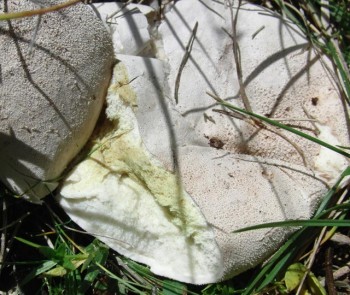
How to Identify Edible Puffballs
- Don’t get puffballs that are past their prime. They are past their prime when you touch/poke/step on them and they puff poisonous spores or when you slice them in half and they are any color other than pure white on the inside.
- Make sure they are puffballs. Puffballs do not have stems, caps, or gills separate from the rest of the mushroom. There are some poisonous mushrooms which, when young, may look round like puffballs because their stems are still underdeveloped. To confirm that a mushroom is an edible puffball, slice it down the middle to make sure there are no separate parts or gills.
- Make sure they are not the Pigskin poison puffball (Scleroderma). I read about this mushroom, which is not a real puffball at all but an earthball, at “Wildman” Steve Brill’s website. Unlike edible puffballs, which are soft and creamy on the inside, the interior of an earthball is hard.
Field Identification
Those are the basic steps, but let me now explain a bit more how Gregg and I made sure to harvest only the best puffballs in the field, lest we add a passé puffball to the bag and pollute our harvest with puffy poisonous spores.
First, we tested the mushrooms visually by their shape. A firm, round shape is a good clue that a puffball is prime for harvesting. Puffballs starting to shrink inward upon themselves, causing an uneven surface, may indicate the interior changes that render them inedible. You can also sense if a puffball is getting soft on the inside by touching it; it feels softer and hollower than the ripe-for-eating kind.
The ultimate test is to cut a puffball open or to step on it to see if it puffs or is any color other than white on the inside. When doing so, it is important not to get your hand or mouth close to it, because that puffy stuff can get all over you.
The puffballs that passed the test went into the bag. We found approximately 15 mushrooms ranging from the size of my fist to the size of a coin. We found them all out in the open meadow, so judging by that and a comparison to their appearance at coloradomushrooms.com, I’m thinking they were all Western Giants.
Home Identification
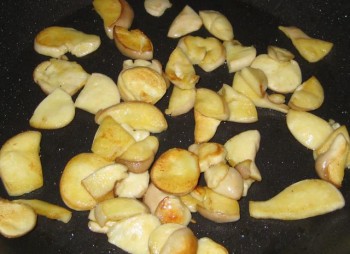
At home we washed them, although I later read at “Wildman” Steve Brill’s site that you shouldn’t wash giant puffballs because they become too soggy to fry. (Everything turned out okay, luckily.) Then we cut them in half lengthwise and confirmed there were no underdeveloped stems or disjointed parts and that they were soft and pure white on the inside. One of our big ones was just starting to show some yellow, so we decided to play it safe and sadly tossed the halved fungus off the deck, hoping the animals would eat it.
Puffball Preparation Experiment
We sliced some of the puffballs and fried them up in fake butter. I have say, for this purpose above all others, the fake butter was inferior to the real thing. The mushrooms were still good, but not the puffballs of my memory. Regardless, they turned a beautiful gold-yellow and went well with the chicken. Gregg described the flavor as “pronounced” and “earthy.”
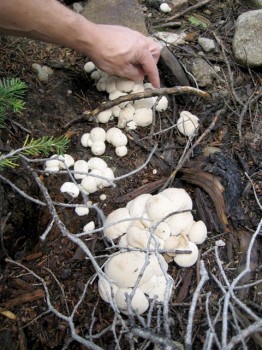
Puffballs, Puffballs, Everywhere
“Why don’t you take a look for mushrooms in the woods around our house?” Gregg suggested yesterday as he headed out to dig some holes for the deck we’ll be building. I had barely stepped off the end of the back yard when, lo and behold, there they were—approximately 100 small puffballs growing in clusters waiting just for me! I think they might be Gem Studded Puffballs (Lycoperdon perlatum), which grow in the forest and have small spines on top, but I guess there’s a chance they could be Pear Shaped Puffballs (Lycoperdon pyriforme), which grow in similar habitats. In any case, both are edible. One interesting note, however—they look almost like they have stems on account of their shape, in particular the part of the mushroom that extends into the dirt, but in cutting them open I find that they pass the puffball tests explained above.
Ever since that fateful day up on the mountain, a world has opened up in front of my eyes, and I am seeing mushrooms everywhere. The timing is good, too, as Gregg and I signed up for a “Can I eat this?” mushroom hike with Colorado Mountain College on August 19 in Keystone, and I am looking forward to expanding my foraging beyond puffballs.
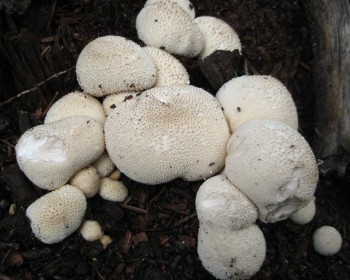
As I stooped to gather a big Tupperware container full of these smaller mushrooms, I sensed Gregg’s initial excitement beginning to waver. “I’m just worried I’m going to get sick of puffballs,” he said, in answer to my inquiry. After all, we ate them for dinner the night before followed by lunch the next day.
But not to worry. I read that if you cook the mushrooms first, they freeze well—so I’ll be trying that too now that the harvest has become so abundant. Aside from that, I’m certain I can eat enough for two, especially after we get our hands on some real butter.
Safety Note:
The Colorado Mycological Society has a good list of safety tips to adhere to when “Collecting for the Table,” including the advice to avoid “LBM’s” (Little Brown Mushrooms) and to “Put a few specimens of the mushroom you plan to eat in the refrigerator, so that a mycologist can positively identify the genera and species if it turns out a mistake has been made.”
Disclaimer: Wild mushroom hunting and eating should be conducted with great care, so if you intend to do so, be sure to read and adhere to safety recommendations, and to taste mushrooms only after a positive identification has been made and in small quantities at first. This website and its author will not be held accountable! Thanks.

hi, thought i would share a bit of my knowledge of puffballs! the pix of the maine puffball ozzing icky brown spores is most probably a gem-studded puffball (named thus because it looks like it has little jewels all over the surface). the ones you say almost looked like they had a stem are most probably pear-shaped puffballs. they have a noticeabley pear shape, again, hence the name. they often have a sort of granular surface which can be brushed off fairly easily. hope this helps!
p.s. i have studied mycology for nearly 10 yrs now & love sharing/learning new stuff…if you need help with any info/ID of any fungi (esp. edible ones) i would be glad to assist if i can, just email me 🙂
Thank you very much for your helpful information. I found some 5-inch puffballs while out walking and brought them home. Then I went online to find out all that I could. I read up on both Calvatia and Bovista types, and it sounded like what I had was edible. (Probably Calvatia pachyderma, because it has a thick and leathery peridium; it’s the right size, shape and color; and it also grows in my state.)
Then after much surfing I found your website, which also helped to put my mind at ease, just in case it was a different kind of Calvatia, or even a different kind of puffball. I sliced it open and the gleba was almost pure white, with some tiny brown spots near the base. Being extra cautious, I tried a very small piece and put the rest in the fridge. An hour later, I still feel fine. I’ll probably try more tomorrow.
I did have one question, about the gleba. Every site I’ve read says to be sure the gleba is pure white, and not turning yellow. The first puffball I sliced open, it was almost all white, but towards the base where it was in the ground there was a bit of brownish area. Then some tiny brown flecks up higher. I trimmed the brown patch off with a generous margin around it. The part that I tried had no tiny brown flecks; but there are still some tiny brown flecks in the part that’s in the fridge. But it’s not yellow at all – just very white with very tiny brown specks. So should I avoid any part that has those tiny dots? Or should I throw it all away? I’m inclined to eat only the part that’s pure white, and not worry about the part with the specks.
(And I realize that you might be reluctant to advise on that, but I would appreciate any information or links. My main point of confusion is that the gleba is not yellowish at all; but it does have tiny dark specks. So I would like to know if those are spores forming; or if they are likely something else, like perhaps insect eggs.)
Just a quick follow-up note to say that I’ve eaten both puffballs now (sliced and sauteed in butter) and they were quite delicious. I like them much better than the standard mushrooms that I find at the grocery store. Even more important – I’m still alive after eating them. (Even though there were some very miniscule brown speckles in the white gleba.) I’ve seen these mushrooms growing around here for years, but I was never brave enough to try one. Now my only regret is having waited that long. Thanks again for the information, very helpful.
Hi Dee, Thanks for the follow up. I’m not sure if you received my email to that effect, but is true I was hesitant to comment on the brown flecks, having never experienced them myself. I emailed some mushroom experts so if I hear anything specific to what you found, I’ll post it here. In the meantime, I’m so glad you enjoyed the puffballs & everything came out all right.